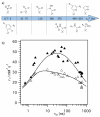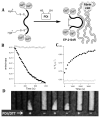MR imaging probes: design and applications
- PMID: 25376893
- PMCID: PMC5155710
- DOI: 10.1039/c4dt02958e
MR imaging probes: design and applications
Abstract
This perspective outlines strategies towards the development of MR imaging probes that our lab has explored over the last 15 years. Namely, we discuss methods to enhance the signal generating capacity of MR probes and how to achieve tissue specificity through protein targeting or probe activation within the tissue microenvironment.
Figures










Similar articles
-
Molecular Magnetic Resonance Imaging with Gd(III)-Based Contrast Agents: Challenges and Key Advances.J Am Chem Soc. 2019 Oct 30;141(43):17025-17041. doi: 10.1021/jacs.9b09149. Epub 2019 Oct 17. J Am Chem Soc. 2019. PMID: 31593630 Free PMC article. Review.
-
Basic MR relaxation mechanisms and contrast agent design.J Magn Reson Imaging. 2015 Sep;42(3):545-65. doi: 10.1002/jmri.24787. Epub 2015 May 14. J Magn Reson Imaging. 2015. PMID: 25975847 Free PMC article. Review.
-
Multifunctional Magnetic Resonance Imaging Probes.Recent Results Cancer Res. 2020;216:189-226. doi: 10.1007/978-3-030-42618-7_6. Recent Results Cancer Res. 2020. PMID: 32594388 Review.
-
Development and in vitro study of a bi-specific magnetic resonance imaging molecular probe for hepatocellular carcinoma.World J Gastroenterol. 2019 Jun 28;25(24):3030-3043. doi: 10.3748/wjg.v25.i24.3030. World J Gastroenterol. 2019. PMID: 31293339 Free PMC article.
-
PET-MR and SPECT-MR multimodality probes: Development and challenges.Theranostics. 2018 Nov 29;8(22):6210-6232. doi: 10.7150/thno.26610. eCollection 2018. Theranostics. 2018. PMID: 30613293 Free PMC article. Review.
Cited by
-
Nanogels as imaging agents for modalities spanning the electromagnetic spectrum.Mater Horiz. 2016 Jan 21;3(1):21-40. doi: 10.1039/c5mh00161g. Epub 2015 Oct 19. Mater Horiz. 2016. PMID: 27398218 Free PMC article. Review.
-
Molecular Magnetic Resonance Imaging Using a Redox-Active Iron Complex.J Am Chem Soc. 2019 Apr 10;141(14):5916-5925. doi: 10.1021/jacs.9b00603. Epub 2019 Mar 28. J Am Chem Soc. 2019. PMID: 30874437 Free PMC article.
-
An ultra-sensitive T 2-weighted MR contrast agent based on Gd3+ ion chelated Fe3O4 nanoparticles.RSC Adv. 2020 May 12;10(31):18054-18061. doi: 10.1039/d0ra01807d. eCollection 2020 May 10. RSC Adv. 2020. PMID: 35517217 Free PMC article.
-
Free-base porphyrins as CEST MRI contrast agents with highly upfield shifted labile protons.Magn Reson Med. 2019 Aug;82(2):577-585. doi: 10.1002/mrm.27753. Epub 2019 Apr 10. Magn Reson Med. 2019. PMID: 30968442 Free PMC article.
-
Screening of ligands for redox-active europium using magnetic resonance imaging.Bioorg Med Chem. 2018 Oct 15;26(19):5274-5279. doi: 10.1016/j.bmc.2018.04.001. Epub 2018 Apr 4. Bioorg Med Chem. 2018. PMID: 29653832 Free PMC article.
References
-
- Young IR. Methods in Biomedical Magnetic Resonance Imaging and Spectroscopy. John Wiley & Sons Ldt.; Chichester: 2000.
-
- Edelman GM, Hesselink JR, Zlatkin MB, Crues JV., III . Clinical Magneic Resonance Imaging. Volume 3. Elsevier Health; St. Louis: 2006.
-
- Ward K, Aletras A, Balaban R. J. Magn. Res. 2000;143:79. - PubMed
-
- Harvey P, Blamire AM, Wilson JI, Finney K-LN, Funk AM, Senanayake PK, Parker D. Chem. Sci. 2013;4:4251.
Publication types
MeSH terms
Substances
Grants and funding
LinkOut - more resources
Full Text Sources
Other Literature Sources
Medical
Miscellaneous

